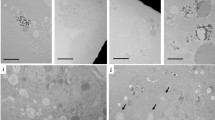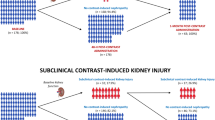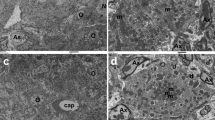Abstract
Gadolinium chelates are commonly used to improve tissue contrast in MRI. Until recently the use of gadolinium was thought to be risk-free compared with alternative contrast agents. Recent studies, however, have raised serious concerns regarding the safety of gadolinium chelates. Although safe in patients with normal kidney function, administration of these agents in people with renal dysfunction can result in up to three clinical problems that the nephrologist should be familiar with. The first is nephrogenic systemic fibrosis (NSF), which was initially observed in 1997. Although manifesting primarily in skin, NSF can also cause systemic fibrosis, leading to disabling contractures and even death. Gadodiamide is the agent that has been most frequently associated with NSF, but other chelates might also pose a risk. The second clinical problem is that gadolinium chelates cause acute kidney injury, especially at high doses required for angiography. The third problem is that several laboratory artifacts are associated with gadolinium administration, with pseudohypocalcemia being the most important. The risk of a patient experiencing all three of these complications increases as renal function declines. In light of these problems, nephrologists need to re-evaluate the risks and benefits of gadolinium administration in patients with chronic kidney disease stage 3 or greater, as well as in those with acute kidney injury.
Key Points
-
Originally thought to be safe contrast agents, gadolinium chelates have recently been shown to be associated with the development of nephrogenic systemic fibrosis (NSF) in patients with impaired renal function
-
NSF, previously known as nephrogenic fibrosing dermopathy, occurs only in patients with kidney dysfunction, is characterized by waxy thickening of the skin of the extremities and torso, and commonly leads to joint contractures and immobility
-
The proposed, but not yet proven, etiology of NSF is tissue deposition of free gadolinium that is liberated from chelates, secondary to prolonged gadolinium clearance time due to impaired renal function
-
Treatments for NSF have only been tested informally; the condition has been shown to improve in response to recovery of kidney function
-
Several authorities have issued recommendations for use of gadolinium chelates; most advise caution when considering use of these agents in patients with renal dysfunction
This is a preview of subscription content, access via your institution
Access options
Subscribe to this journal
Receive 12 print issues and online access
$209.00 per year
only $17.42 per issue
Buy this article
- Purchase on Springer Link
- Instant access to full article PDF
Prices may be subject to local taxes which are calculated during checkout
Similar content being viewed by others
References
Caille JM et al. (1983) Gadolinium as a contrast agent for NMR. AJNR Am J Neuroradiol 4: 1041–1042
Tweedle MF (1992) Physicochemical properties of gadoteridol and other magnetic resonance contrast agents. Invest Radiol 27 (Suppl 1): S2–S6
Bousquet JC et al. (1988) Gd-DOTA: characterization of a new paramagnetic complex. Radiology 166: 693–698
AuntMinnie.com (online 21 February 2007) IMV Report: MRI market growing. [http://www.auntminnie.com/index.asp?Sec=sup&Sub=bai&Pag=dis&ItemId=74472] (accessed 19 June 2007)
Thomsen HS (2004) Gadolinium-based contrast media may be nephrotoxic even at approved doses. Eur Radiol 14: 1654–1656
US Food and Drug Administration (online 23 May 2007) Healthcare professional sheet: gadolinium-containing contrast agents for magnetic resonance imaging (MRI) (marketed as Omniscan, OptiMARK, Magnevist, ProHance, and MultiHance). [http://www.fda.gov/cder/drug/InfoSheets/HCP/gccaHCP.htm] (accessed 19 June 2007)
Morcos SK et al. (1999) Contrast-media-induced nephrotoxicity: a consensus report. Contrast Media Safety Committee, European Society of Urogenital Radiology (ESUR). Eur Radiol 9: 1602–1613
Hamm B et al. (1995) Phase I clinical evaluation of Gd-EOB-DTPA as a hepatobiliary MR contrast agent: safety, pharmacokinetics, and MR imaging. Radiology 195: 785–792
Lauffer RB et al. (1998) MS-325: albumin-targeted contrast agent for MR angiography. Radiology 207: 529–538
Kirchin MA et al. (1998) Gadobenate dimeglumine (Gd-BOPTA): an overview. Invest Radiol 33: 798–809
Cacheris WP et al. (1990) The relationship between thermodynamics and the toxicity of gadolinium complexes. Magn Reson Imaging 8: 467–481
Idee JM et al. (2006) Clinical and biological consequences of transmetallation induced by contrast agents for magnetic resonance imaging: a review. Fundam Clin Pharmacol 20: 563–576
Puttagunta NR et al. (1996) Human in vivo comparative study of zinc and copper transmetallation after administration of magnetic resonance imaging contrast agents. Invest Radiol 31: 739–742
Laurent S et al. (2006) Comparative study of the physicochemical properties of six clinical low molecular weight gadolinium contrast agents. Contrast Media Mol Imaging 1: 128–137
Bellin MF et al. (1992) Gd-DOTA: evaluation of its renal tolerance in patients with chronic renal failure. Magn Reson Imaging 10: 115–118
Hammer FD et al. (1999) Gadolinium dimeglumine: an alternative contrast agent for digital subtraction angiography. Eur Radiol 9: 128–136
Kaufman JA et al. (1999) Gadolinium-based contrast agents as an alternative at vena cavography in patients with renal insufficiency—early experience. Radiology 212: 280–284
Prince MR et al. (1996) Nephrotoxicity of high-dose gadolinium compared with iodinated contrast. J Magn Reson Imaging 6: 162–166
Rieger J et al. (2002) Gadolinium as an alternative contrast agent for diagnostic and interventional angiographic procedures in patients with impaired renal function. Nephrol Dial Transplant 17: 824–828
Rofsky NM et al. (1991) Renal lesion characterization with gadolinium-enhanced MR imaging: efficacy and safety in patients with renal insufficiency. Radiology 180: 85–89
Sancak T et al. (2002) Gadodiamide as an alternative contrast agent in intravenous digital subtraction angiography and interventional procedures of the upper extremity veins. Cardiovasc Intervent Radiol 25: 49–52
Spinosa DJ et al. (2000) Lower extremity arteriography with use of iodinated contrast material or gadodiamide to supplement CO2 angiography in patients with renal insufficiency. J Vasc Interv Radiol 11: 35–43
Spinosa DJ et al. (1999) Renal insufficiency: usefulness of gadodiamide-enhanced renal angiography to supplement CO2-enhanced renal angiography for diagnosis and percutaneous treatment. Radiology 210: 663–672
Townsend RR et al. (2000) Safety of intravenous gadolinium (Gd-BOPTA) infusion in patients with renal insufficiency. Am J Kidney Dis 36: 1207–1212
Briguori C (2006) Gadolinium-based contrast agents and nephrotoxicity in patients undergoing coronary artery procedures. Catheter Cardiovasc Interv 67: 175–180
Ergun I et al. (2006) The safety of gadolinium in patients with stage 3 and 4 renal failure. Nephrol Dial Transplant 21: 697–700
Erley CM et al. (2004) Gadolinium-based contrast media compared with iodinated media for digital subtraction angiography in azotaemic patients. Nephrol Dial Transplant 19: 2526–2531
Sam AD et al. (2003) Safety of gadolinium contrast angiography in patients with chronic renal insufficiency. J Vasc Surg 38: 313–318
Akgun H et al. (2006) Are gadolinium-based contrast media nephrotoxic? A renal biopsy study. Arch Pathol Lab Med 130: 1354–1357
Thomsen HS et al. for the Contrast Media Safety Committee of the European Society of Urogenital Radiology (ESUR) (2002) Gadolinium-containing contrast media for radiographic examinations: a position paper. Eur Radiol 12: 2600–2605
Cowper SE et al. (2000) Scleromyxoedema-like cutaneous diseases in renal-dialysis patients. Lancet 356: 1000–1001
Daram SR et al. (2005) Nephrogenic fibrosing dermopathy/nephrogenic systemic fibrosis: report of a new case with literature review. Am J Kidney Dis 46: 754–759
Cassis TB et al. (2006) Nephrogenic fibrosing dermopathy in a patient with acute renal failure never requiring dialysis. Int J Dermatol 45: 56–59
Grobner T (2006) Gadolinium—a specific trigger for the development of nephrogenic fibrosing dermopathy and nephrogenic systemic fibrosis? Nephrol Dial Transplant 21: 1104–1108
Danish Medicines Agency (online 29 May 2006) Investigation of the safety of MRI contrast medium Omniscan [press release]. [http://www.dkma.dk/1024/visUKLSArtikel.asp?artikelID=8931]
Okada S et al. (2001) Safety of gadolinium contrast agent in hemodialysis patients. Acta Radiol 42: 339–341
Deo A et al. (2007) Nephrogenic systemic fibrosis: a population study examining the relationship of disease development to gadolinium exposure. Clin J Am Soc Nephrol 2: 264–267
Centers for Disease Control and Prevention (CDC) (2007) Nephrogenic fibrosing dermopathy associated with exposure to gadolinium-containing contrast agents—St Louis, Missouri, 2002–2006. MMWR Morb Mortal Wkly Rep 56: 137–141
Joffe P et al. (1998) Pharmacokinetics of gadodiamide injection in patients with severe renal insufficiency and patients undergoing hemodialysis or continuous ambulatory peritoneal dialysis. Acad Radiol 5: 491–502
Khurana A et al. (2007) Nephrogenic systemic fibrosis: a review of 6 cases temporally related to gadodiamide injection (omniscan). Invest Radiol 42: 139–145
Marckmann P et al. (2006) Nephrogenic systemic fibrosis: suspected causative role of gadodiamide used for contrast-enhanced magnetic resonance imaging. J Am Soc Nephrol 17: 2359–2362
Thomsen HS et al. (2007) Enhanced computed tomography or magnetic resonance imaging: a choice between contrast medium-induced nephropathy and nephrogenic systemic fibrosis? Acta Radiol 48: 593–596
Broome DR et al. (2007) Gadodiamide-associated nephrogenic systemic fibrosis: why radiologists should be concerned. AJR Am J Roentgenol 188: 586–592
Sadowski EA et al. (2007) Nephrogenic systemic fibrosis: risk factors and incidence estimation. Radiology 243: 148–157
Marckmann P et al. (2007) Case-control study of gadodiamide-related nephrogenic systemic fibrosis. Nephrol Dial Transplant [10.1093/ndt/gfm261]
Weiss AS et al. (2007) A case of nephrogenic fibrosing dermopathy/nephrogenic systemic fibrosis. Nat Clin Pract Nephrol 3: 111–115
Gibby WA et al. (2004) Comparison of Gd DTPA-BMA (Omniscan) versus Gd HP-DO3A (ProHance) retention in human bone tissue by inductively coupled plasma atomic emission spectroscopy. Invest Radiol 39: 138–142
White GW et al. (2006) Comparison of Gd(DTPA-BMA) (Omniscan) versus Gd(HP-DO3A) (ProHance) relative to gadolinium retention in human bone tissue by inductively coupled plasma mass spectroscopy. Invest Radiol 41: 272–278
High WA et al. (2007) Gadolinium is detectable within the tissue of patients with nephrogenic systemic fibrosis. J Am Acad Dermatol 56: 21–26
High WA et al. (2007) Gadolinium is quantifiable within the tissue of patients with nephrogenic systemic fibrosis. J Am Acad Dermatol 56: 710–712
Boyd AS et al. (2007) Gadolinium deposition in nephrogenic fibrosing dermopathy. J Am Acad Dermatol 56: 27–30
Jain SM et al. (2004) Nephrogenic fibrosing dermopathy in pediatric patients. Pediatr Nephrol 19: 467–470
Pöge U et al. (2005) MDRD equations for estimation of GFR in renal transplant recipients. Am J Transplant 5: 1306–1311
Cantarovich M et al. (2006) Poor prediction of the glomerular filtration rate using current formulas in de novo liver transplant patients. Transplantation 82: 433–436
Mendoza FA et al. (2006) Description of 12 cases of nephrogenic fibrosing dermopathy and review of the literature. Semin Arthritis Rheum 35: 238–249
Cowper SE (2003) Nephrogenic fibrosing dermopathy: the first 6 years. Curr Opin Rheumatol 15: 785–790
Gilliet M et al. (2005) Successful treatment of three cases of nephrogenic fibrosing dermopathy with extracorporeal photopheresis. Br J Dermatol 152: 531–536
Levine JM et al. (2004) Involvement of skeletal muscle in dialysis-associated systemic fibrosis (nephrogenic fibrosing dermopathy). Muscle Nerve 30: 569–577
Hubbard V et al. (2003) Scleromyxoedema-like changes in four renal dialysis patients. Br J Dermatol 148: 563–568
Mackay-Wiggan JM et al. (2003) Nephrogenic fibrosing dermopathy (scleromyxedema-like illness of renal disease). J Am Acad Dermatol 48: 55–60
Streams BN et al. (2003) Clinical and pathologic features of nephrogenic fibrosing dermopathy: a report of two cases. J Am Acad Dermatol 48: 42–47
Swartz RD et al. (2003) Nephrogenic fibrosing dermopathy: a novel cutaneous fibrosing disorder in patients with renal failure. Am J Med 114: 563–572
Gibson SE et al. (2006) Multiorgan involvement in nephrogenic fibrosing dermopathy: an autopsy case and review of the literature. Arch Pathol Lab Med 130: 209–212
Jimenez SA et al. (2004) Dialysis-associated systemic fibrosis (nephrogenic fibrosing dermopathy): study of inflammatory cells and transforming growth factor beta1 expression in affected skin. Arthritis Rheum 50: 2660–2666
Kucher C et al. (2006) Nephrogenic fibrosing dermopathy/nephrogenic systemic fibrosis with diaphragmatic involvement in a patient with respiratory failure. J Am Acad Dermatol 54 (Suppl 2): S31–S34
Ting WW et al. (2003) Nephrogenic fibrosing dermopathy with systemic involvement. Arch Dermatol 139: 903–906
Baron PW et al. (2003) Nephrogenic fibrosing dermopathy after liver transplantation successfully treated with plasmapheresis. Am J Dermatopathol 25: 204–209
Hershko K et al. (2004) A variant of nephrogenic fibrosing dermopathy with osteoclast-like giant cells: a syndrome of dysregulated matrix remodeling? J Cutan Pathol 31: 262–265
Ruiz-Genao DP et al. (2005) Osseous metaplasia in the setting of nephrogenic fibrosing dermopathy. J Cutan Pathol 32: 172–175
Edward M et al. (2007) Cutaneous mucinosis associated with dermatomyositis and nephrogenic fibrosing dermopathy: fibroblast hyaluronan synthesis and the effect of patient serum. Br J Dermatol 156: 473–479
Kucher C et al. (2005) Histopathologic comparison of nephrogenic fibrosing dermopathy and scleromyxedema. J Cutan Pathol 32: 484–490
Kafi R et al. (2004) UV-A1 phototherapy improves nephrogenic fibrosing dermopathy. Arch Dermatol 140: 1322–1324
Yerram P et al. (2007) Nephrogenic systemic fibrosis: a mysterious disease in patients with renal failure—role of gadolinium-based contrast media in causation and the beneficial effect of intravenous sodium thiosulfate. Clin J Am Soc Nephrol 2: 258–263
Chung HJ and Chung KY (2004) Nephrogenic fibrosing dermopathy: response to high-dose intravenous immunoglobulin. Br J Dermatol 150: 596–597
Choyke PL et al. (1995) Clearance of gadolinium chelates by hemodialysis: an in vitro study. J Magn Reson Imaging 5: 470–472
Dorsam J et al. (1995) Elimination of gadolinium-DTPA by peritoneal dialysis. Nephrol Dial Transplant 10: 1228–1230
Okada S et al. (2003) Effect of the surface potential of the hemodialysis membrane and the electrical charge of the gadolinium contrast medium on dialyzability. J Nippon Med Sch 70: 12–15
Saitoh T et al. (2006) Dialyzability of gadodiamide in hemodialysis patients. Radiat Med 24: 445–451
Schuhmann-Giampieri G and Krestin G (1991) Pharmacokinetics of Gd-DTPA in patients with chronic renal failure. Invest Radiol 26: 975–979
Swan SK et al. (1999) Pharmacokinetics, safety, and tolerability of gadoversetamide injection (OptiMARK) in subjects with central nervous system or liver pathology and varying degrees of renal function. J Magn Reson Imaging 9: 317–321
Swan SK et al. (1999) Safety and pharmacokinetic profile of gadobenate dimeglumine in subjects with renal impairment. Invest Radiol 34: 443–448
Ueda J et al. (1999) Permeability of iodinated and MR contrast media through two types of hemodialysis membrane. Eur J Radiol 31: 76–80
Ueda J et al. (1998) Permeability of gadolinium-DTPA through two types of hemodialysis membrane. Invest Radiol 33: 734–737
Emerson J and Kost G (2004) Spurious hypocalcemia after Omniscan- or OptiMARK-enhanced magnetic resonance imaging: an algorithm for minimizing a false-positive laboratory value. Arch Pathol Lab Med 128: 1151–1156
Lin J et al. (1999) Interference of magnetic resonance imaging contrast agents with the serum calcium measurement technique using colorimetric reagents. J Pharm Biomed Anal 21: 931–943
Lowe A et al. (2005) Interference of gadolinium-containing contrast-enhancing agents with colorimetric calcium laboratory testing. Invest Radiol 40: 521–525
Moore CD et al. (2006) Spurious hypocalcemia after gadodiamide-enhanced magnetic resonance imaging: a case report and review of the literature. Rev Urol 8: 165–168
Prince MR et al. (2003) Gadodiamide administration causes spurious hypocalcemia. Radiology 227: 639–646
Proctor KA et al. (2004) Gadolinium magnetic resonance contrast agents produce analytic interference in multiple serum assays. Am J Clin Pathol 121: 282–292
Normann PT et al. (1995) Interference of gadodiamide injection (OMNISCAN) on the colorimetric determination of serum calcium. Scand J Clin Lab Invest 55: 421–426
Kang HP et al. (2004) Model for predicting the impact of gadolinium on plasma calcium measured by the o-cresolphthalein method. Clin Chem 50: 741–746
Medicines and Healthcare products Regulatory Agency (online 7 February 2007) Public assessment report: increased risk of nephrogenic fibrosing dermopathy/nephrogenic systemic fibrosis and gadolinium-containing MRI contrast agents. [http://www.mhra.gov.uk/home/idcplg?IdcService=SS_GET_PAGE&ssDocName=CON2030229&ssSourceNodeId= 221&ssTargetNodeId=221]
Kanal E et al. (2007) ACR guidance document for safe MR practices: 2007. AJR Am J Roentgenol 188: 1447–1474
Van Moore A Jr (2007) Commentary on “ACR guidance document for safe MR practices: 2007”. AJR Am J Roentgenol 188: 1446
Kuo PH et al. (2007) Gadolinium-based MR contrast agents and nephrogenic systemic fibrosis. Radiology 242: 647–649
Levey AS et al. (1999) A more accurate method to estimate glomerular filtration rate from serum creatinine: a new prediction equation. Modification of Diet in Renal Disease Study Group. Ann Intern Med 130: 461–470
Acknowledgements
Charles P Vega, University of California, Irvine, CA, is the author of and is solely responsible for the content of the learning objectives, questions and answers of the Medscape-accredited continuing medical education activity associated with this article.
Author information
Authors and Affiliations
Corresponding author
Ethics declarations
Competing interests
The authors declare no competing financial interests.
Rights and permissions
About this article
Cite this article
Penfield, J., Reilly, R. What nephrologists need to know about gadolinium. Nat Rev Nephrol 3, 654–668 (2007). https://doi.org/10.1038/ncpneph0660
Received:
Accepted:
Issue Date:
DOI: https://doi.org/10.1038/ncpneph0660
This article is cited by
-
Adaptive iron-based magnetic nanomaterials of high performance for biomedical applications
Nano Research (2022)
-
High-resolution T1 MRI via renally clearable dextran nanoparticles with an iron oxide shell
Nature Biomedical Engineering (2021)
-
Enhancing magnetic resonance imaging of bio-based nano-contrast via anchoring manganese on rod-shaped cellulose nanocrystals
Cellulose (2021)
-
Non-contrast renal MRA using multi-shot gradient echo EPI at 3-T MRI
European Radiology (2021)



